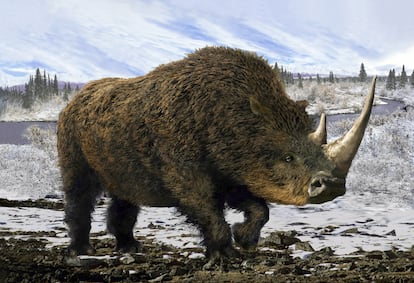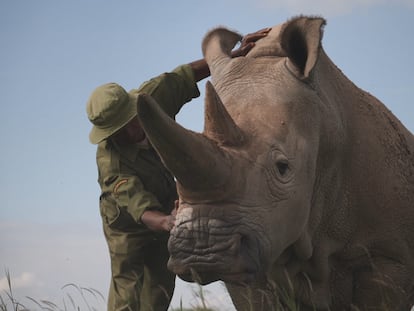Humans and climate change drove the woolly rhino to extinction
Of the more than 60 species of megafauna that existed during the last ice age, only eight remain and most are in critical danger of disappearing

It was what the military calls an encircling maneuver. After 2.5 million years thriving throughout Eurasia, the woolly rhinoceros (Coelodonta antiquitatis) retreated further and further east and further and further north, as they fled the unfavorable climate. The species was then finished off by Neanderthals and modern humans. In the end, when the Ice Age had passed and the planet was entering the present era, only a few remained in the extreme northeast of Siberia. They did not make it across the Bering Strait to America; they became extinct earlier. Now, the modeling of that retreat has made it possible to apportion the blame: climatic swings created their deathbed and human hunting put the nail in the coffin. The authors of the new study believe that four of the five remaining rhino species are also on the same highway to extinction. But they have a few ways out left.
The extinction of most of the late Pleistocene megafauna (a category that loosely refers to animals weighing more than 1,000 kilograms) is one of the biggest enigmas for paleontologists. This group includes up to 65 species that existed long before the last Ice Age began (about 126,000 years ago), such as mammoths, glyptodonts, mastodons, woolly rhinos and cave bears. They were still on Earth when modern humans began their expansion from Africa, reaching Western Europe about 55,000 years ago. For millennia, Neanderthals, Homo sapiens and various large species — both megaherbivores and carnivores that would make the lion look like a large cat — lived together. But at the end of this period, which culminated with the end of the glaciation some 12,000 years ago, giving way to the warm Holocene period, the remaining species of large animals could be counted on the fingers of one hand. Today, leaving aside the European and American bison, only hippopotamuses, elephants and rhinoceroses remain in Africa and other species of the latter two in South Asia. The study of the woolly rhinoceros could help determine what happened to the extinct species and what awaits the remaining ones.
Researchers from several European, Australian and Chinese universities compiled hundreds of references to woolly rhinoceros remains (either in the fossil record, in the form of bones, or their ancient DNA) from the last 52,000 years and fed it into a simulation model, which also included the evolution of the climate in Eurasia (the species could be found from the Iberian peninsula to the eastern edge of Asia). This modeling approach also took into account the Neanderthal presence in the fossil record and modern human’s progressive occupation of territory. The dating and location of each record allowed the researchers to create a dynamic map of how the woolly rhino’s distribution evolved over time. The map and the entire work, published in the scientific journal PNAS, show that climate change did not wipe them out, as the Tyrians claim. Neither did the different human species, as the Trojans claim. It was a combination of both factors.
“We gave it the coup de grâce, but it was a species that was already very sick, it had entered into negative, recessive dynamics, mainly due to climate change,” says David Nogués, professor at the University of Copenhagen (Denmark) and co-author of the study. When modern humans arrived and expanded across Eurasia in the middle of the Ice Age, they incorporated megaherbivores such as the mammoth or the woolly rhinoceros into their diet. But the fossil record does not detect a significant decline in animal populations until many millennia later. “We detect the differences when the planet moves towards the glacial maximum,” he adds.
The last Ice Age, called the Würm glaciation, had a cold peak between 26,000 and 20,000 years ago, when ice in the northern hemisphere covered as far as the upper fringe of what is now the United States and over Germany. And further south, there were hundreds of miles of permafrost. “What happened to the ecosystems is that plant productivity collapsed. That meant that herbivores had less to eat,” explains Nogués.
The coffin was ready. The woolly rhino began disappearing from Europe and almost all of Siberia, with the species restricted to the southern Siberian strip, the Tibetan plateau and, in the extreme north, Beringia. According to the fossil record, the rhino also became a bigger part of the diet of modern humans, who in addition to spears started to use arrows and other projectiles as hunting weapons. “This showed that from 30,000 years ago, a combination of cooling temperatures and low but sustained hunting by humans caused the woolly rhinoceros to contract its distribution southward, trapping it in a scattering of isolated and rapidly deteriorating habitats at the end of the Last Ice Age,” said Damien Fordham, from the University of Adelaide and lead author of the study, in a press release.
But the nail in the coffin was the shift to warmer climates. After the glacial maximum, a slow warming of about 10,000 years begins. The ice sheets retreat, freeing up large areas that were once again available to megaherbivores. “As Earth thawed and temperatures rose, populations of woolly rhinoceros were unable to colonize important new habitats opening up in the north of Eurasia, causing them to destabilize and crash, bringing about their extinction,” said Fordham.
The researchers acknowledge that they do not know exactly what happened, but woolly rhinos do not reappear in the fossil record in most of the territory they once occupied. They use ecological systems theory to explain this decline: the remaining groups were in a fragmented, isolated habitat. From what is known about modern rhinoceroses, their mobility is very limited and with fragmentation, there is less genetic exchange between populations, which must have reduced their capacity to adapt to environmental changes. And with each generation, there was a lower number of rhinoceroses due to hunting.
The last woolly rhinos survived, like mammoths, in the far northeast, on the Asian side of the Bering Strait. During the glacial maximum, Beringia remained relatively ice-free and became a climatic refuge. But the species was doomed. The last specimens of the woolly rhino became extinct just over 9,000 years ago.
“Extinctions are not the extinction of the last individual. They are not an event, they are a process,” Nogués stresses. “There are different highways that lead to extinction. There is not just one, but what we know is that the one that led to the extinction of the woolly rhinoceros is the one that all other rhinoceros species are on, with the same processes: habitat fragmentation, hunting, inability of populations to connect....”
This is happening to the black rhino and the three Asian rhino species. The northern white subspecies is virtually extinct, with only two specimens left in captivity. But Nogués argues that this time, unlike in the past, humans are aware of their responsibility and ability to provide an alternative to extinction: “There is a species, the white rhinoceros, whose population in the south barely numbered 100 animals a century ago and now there are more than 18,000 specimens. It is one of the classic examples that, when you combine money, desire, resources, means, and political decisions, you can restore the natural world.”
Sign up for our weekly newsletter to get more English-language news coverage from EL PAÍS USA Edition
Tu suscripción se está usando en otro dispositivo
¿Quieres añadir otro usuario a tu suscripción?
Si continúas leyendo en este dispositivo, no se podrá leer en el otro.
FlechaTu suscripción se está usando en otro dispositivo y solo puedes acceder a EL PAÍS desde un dispositivo a la vez.
Si quieres compartir tu cuenta, cambia tu suscripción a la modalidad Premium, así podrás añadir otro usuario. Cada uno accederá con su propia cuenta de email, lo que os permitirá personalizar vuestra experiencia en EL PAÍS.
¿Tienes una suscripción de empresa? Accede aquí para contratar más cuentas.
En el caso de no saber quién está usando tu cuenta, te recomendamos cambiar tu contraseña aquí.
Si decides continuar compartiendo tu cuenta, este mensaje se mostrará en tu dispositivo y en el de la otra persona que está usando tu cuenta de forma indefinida, afectando a tu experiencia de lectura. Puedes consultar aquí los términos y condiciones de la suscripción digital.
More information
Archived In
Últimas noticias
Welcome to the post-religion era: The idea of Christianity as the absolute truth has become obsolete
‘I thought you would like it’: The risky sexual practice popularized by TV shows and TikTok
The digitalization of tourism: ‘They promise experiences and gave us the worst possible one’
Mexican peso defies uncertainty with forecasts of a new period of stability in 2026
Most viewed
- Sinaloa Cartel war is taking its toll on Los Chapitos
- Oona Chaplin: ‘I told James Cameron that I was living in a treehouse and starting a permaculture project with a friend’
- Reinhard Genzel, Nobel laureate in physics: ‘One-minute videos will never give you the truth’
- Why the price of coffee has skyrocketed: from Brazilian plantations to specialty coffee houses
- Silver prices are going crazy: This is what’s fueling the rally










































